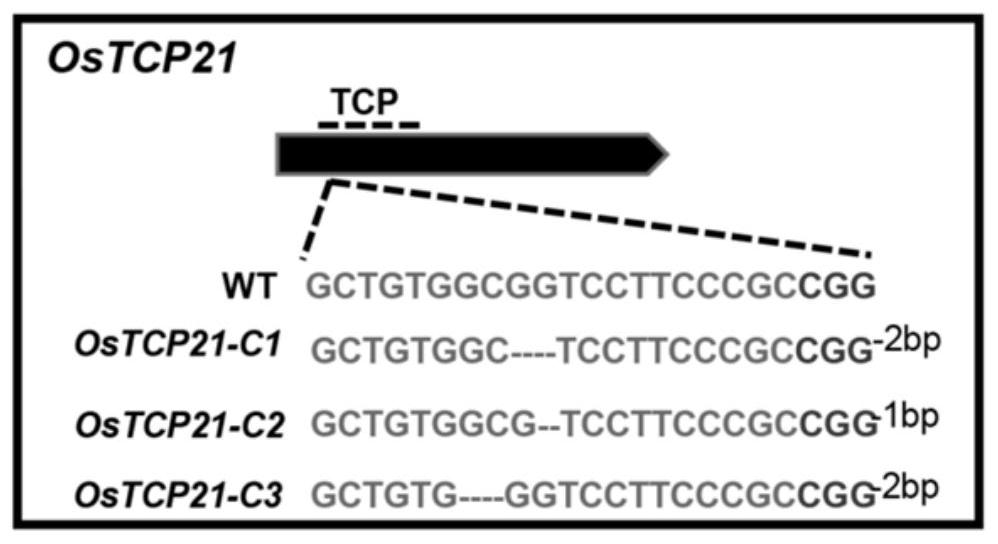Application of transcription factor to oryza sativa breeding and oryza sativa breeding method
A technology of transcription factor, rice, applied in the direction of application, chemical instrument and method, botany equipment and method, etc.
- Summary
- Abstract
- Description
- Claims
- Application Information
AI Technical Summary
Problems solved by technology
Method used
Image
Examples
Embodiment 1
[0041]Example 1: Construction of OSTCP21 gene super expression plants
[0042]The RNA of Rice Nikami (Ni) was extracted, and it reversed into cDNA, using primer to expand the cDNA of the OSTCP21 gene by PCR (see SEQ ID NO.1, and OSTCP21 gene) by PCR by PCR (protein sequence of OSTCP21 gene). Sequence see SEQ ID No. 2). The primers are F1 and R1, respectively:
[0043]F1: 5'-gagctcggctccggggggggggggcccccatgagctcgcggggcagcaa-3 '(SEQ ID NO.5, enzyme-containing point KPNI);
[0044]R1: 5'-TccaagggcGaattggtcgctgctTgcccttctcctTgatgt-3 '(SEQ ID No.6, enzyme-containing point Bamhi).
[0045]The cDNA of the OSTCP21 gene was then brought into a PCAMBIA-1306 vector (PCAMBIA-1306 vectors from Cambia) by two enzyme-cutting sites KPNI and BamHI, and the super-metallic carrier OSTCP-P1306 of the OSTCP21 gene was constructed. Using Agrobacterium EHA105-mediated genetic conversion method, the super-expression vector is introduced into the normal rice variety in Japan.
[0046]All transgenic seedlings obtained were...
Embodiment 2
[0051]Example 2: Construction of Osgamyb gene super expression plants
[0052]RNAs were extracted in rice, and reverse it into cDNA, using primers to amplify the cDNA of the OSTCP21 gene by PCR (see SEQ ID NO.3, the protein sequence of the Osgamyb gene, see SEQ ID NO.4). The primers are:
[0053]F3: 5'-gagctcggggggggggggggggggatccatgtatcggggtggagagcgagag-3 '(SEQ ID No.9, enzyme-containing point kPni);
[0054]R3: 5'-TccaaggcGAATTGTCGACTTGAATTGAATTGTCGACTTGAATTGAATTGACATTCACAGGCC-3 '(SEQ ID No.10, enzyme-containing point BamHi).
[0055]The super-volume carrier OSGAMYB-P1306 of the Osgamyb gene was constructed by KPNI and BamHi. (PCAMBIA-1306 vectors were purchased from Cambia). Using Agrobacterium EHA105-mediated genetic conversion method, the super-expression vector is introduced into the normal rice variety in Japan.
[0056]All transgenic seedlings obtained were cultured with a normal nutrient solution of gamma maternal, and if the seedlings were able to grow normally, the transgenic plants wer...
experiment example 1
[0071]Experimental Example 1: Hydroponic test
[0072]The seeds of super-expression plants (Example 1), Japan (Ni) and gene knockout plants (Comparative Example 1) were submerged by distilled water with distilled water for 3 days and cultured for 7 days, and the nutrient liquid culture and nutrient formulation were transferred to rice nutrient solution. Referring to the prior art routine international rice formulation, 40 days were cultured, and the water rice form was observed, and the number of rice tillers and biomass (ie, seedlings were fresh), and the phosphor photographed microscope was taken. Tiller bud photo resultsFigure 5 As shown, it can be seen from the figure that the OSTCP21 gene super-expression plants are increased compared to the total number of tillers and tiller buds in the Japanese sunny plants, and achieve significant differences. The OSTCP21 gene knockout mutant plants were reduced by tillement and tillers in compared to Japanese sunny plants, and achieved signifi...
PUM
 Login to View More
Login to View More Abstract
Description
Claims
Application Information
 Login to View More
Login to View More - R&D
- Intellectual Property
- Life Sciences
- Materials
- Tech Scout
- Unparalleled Data Quality
- Higher Quality Content
- 60% Fewer Hallucinations
Browse by: Latest US Patents, China's latest patents, Technical Efficacy Thesaurus, Application Domain, Technology Topic, Popular Technical Reports.
© 2025 PatSnap. All rights reserved.Legal|Privacy policy|Modern Slavery Act Transparency Statement|Sitemap|About US| Contact US: help@patsnap.com



